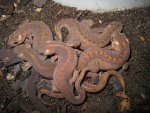I have a group of CB 2007 O. ophryticus. At least one male appears to be developing a hint of a crest. They are not full adult size, though. I would say they are the same size as adult L. helveticus.
I am very afraid of putting them into a semiaquatic setup too early in their life (or at the wrong time of the season). I have heard too many sad stories of this species dieing when aquatic or too wet.
Are there any experienced Ommatotriton keepers who could venture a guess? Should these guys be given water this year, or is it better (safer) to wait another year?
I am very afraid of putting them into a semiaquatic setup too early in their life (or at the wrong time of the season). I have heard too many sad stories of this species dieing when aquatic or too wet.
Are there any experienced Ommatotriton keepers who could venture a guess? Should these guys be given water this year, or is it better (safer) to wait another year?


